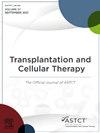为儿童造血干细胞移植的适应性平台试验“BANDICOOT”共同设计了一个新的顺序终点。
IF 3.6
3区 医学
Q2 HEMATOLOGY
引用次数: 0
摘要
适应性平台试验(APT)提供了在同一目标人群中,跨多个领域(干预)纳入多个研究问题的能力,并能够以永久的方式添加新问题。APT尤其适用于儿科造血干细胞移植(HCT);异质性高,试验可用性有限,死亡率高。理想情况下,APT中的所有域都具有相同的主要端点。因此,将多种临床结果合并为单一结果测量的多个类别的顺序终点对APTs特别有吸引力。不幸的是,没有公认的儿童HCT试验的顺序终点。本文旨在描述用于共同设计儿科HCT APT - BANDICOOT的新型主要顺序终点的方法。BANDICOOT是一项旨在;“建立一个适应性的新型平台设计:改善造血干细胞移植的并发症、成本效益、结果和总体生存”。这一过程的结果确定了两个可能使用的顺序终点,一个侧重于器官支持,另一个侧重于器官支持、病毒再激活和免疫重建的组合。我们探索了从电子医疗记录中提取这些端点所需的数据,我们将利用这些数据来验证端点,并确定哪些端点将用于APT BANDICOOT。在APT越来越多地被用于回答临床护理中的重要问题的时代,本文描述了一种可重复的策略,用于设计高质量和有意义的顺序终点。本文章由计算机程序翻译,如有差异,请以英文原文为准。
Co-designing a Novel Ordinal Endpoint for an Adaptive Platform Trial, BANDICOOT, in Pediatric Hematopoietic Stem Cell Transplant
An adaptive platform trial (APT) offers the ability to incorporate several research questions in the same target population across multiple domains (interventions), with the ability to add new questions in a perpetual manner. An APT is particularly appealing for pediatric hematopoietic stem cell transplant (HCT); an area of high heterogeneity, limited trial availability, and high mortality. Ideally, all domains in an APT would have the same primary endpoint. Therefore, an ordinal endpoint with multiple categories that combines various clinical outcomes into a single outcome measure is particularly appealing for APTs. Unfortunately, there is no accepted ordinal endpoint for pediatric HCT trials. This article aims to describe the methodology used to co-design a novel primary ordinal endpoint for the pediatric HCT APT — BANDICOOT. BANDICOOT is a study that aims to build an adaptive novel platform design — improving the complications, cost-effectiveness, outcomes, and overall survival from hematopoietic stem cell transplantation.The results of this process identified two potential ordinal endpoints that could be used, one focusing on organ support and the other on a combination of organ support, viral reactivation, and immune reconstitution. We explored the data extraction required for these endpoints from electronic medical records that we will utilize to validate the endpoints and determine which will be used in the APT BANDICOOT. In an era in which APTs are becoming increasingly utilized to answer important questions in clinical care, this article describes a reproducible strategy for the design of high-quality and meaningful ordinal endpoints.
求助全文
通过发布文献求助,成功后即可免费获取论文全文。
去求助
来源期刊

Transplantation and Cellular Therapy
Medicine-Hematology
CiteScore
7.00
自引率
15.60%
发文量
1061
审稿时长
51 days
 求助内容:
求助内容: 应助结果提醒方式:
应助结果提醒方式:


